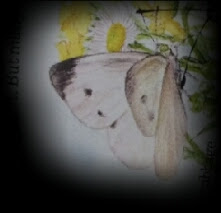Moths and butterfly are more alike than different and can be hard to classify.
Butterflies,as a rule,fly by day,are brightly coloured,perch with folded wings,and have thin,clubbed antennae.
Moths have feathery or thickened antennae,dull colours,and wide bodies.they perch with open wings and fly at night.But many species break these rules.
Rules and exceptions:
Most butterfly antennae are simple stalks,slightly thickened or clubbed at the tip.
Most moths have delicately branching feathery antennae.but this is not always the case.
Skippers' antennae are farther apart at the base and end in pointed,curved clubs.
Certain moths have antennae as simple as a butterfly's.
Similarly , most butterflies fold their wings at rest.
While moths spread their out ,but there are many exceptions.
The typical cabbage butterfly has a slim abdomen and perches with closed wings.
The Kaniska canace:
Butterfly of the Nymphalidae family rests with its wings open.
The smoky moth:
Zygaenidae family also flies in daylight.
The hummingbird moth: it flies by day ,feeding on nectar,as hummingbids do.
The swallowtail :
This butterfly displays its colours with its wings wide open.
This male hairstreak butterfly of the Lycaenidae family has golden green wings.
Parnara guttata:
A moth like butterfly called a skipper with a thick abdomen and dun wings.
The Melanidae:
This butterfly is most active around us.
A callidulid silk moth perches with its wings closed.as most butterflies do.
The Japanese:
Giant silk moth flies by night ,behaviour typical of moths.
The tiger moths:
Of this family Arctiidae are vivid night fliers.
At rest :
The underwing moth conceals its bright orange or yellow hind wing.
Moths and butterflies makeup the insect order Lepidoptera ,whose name means scale-winged.Except for a few moths that have mouths adaptef for chewing,adult moths and buttetflies live on liquid food or no food at all.
Those that feed take flower nectar up through a tube like proboscis.
Some adults take no food,emerging from their cocoons only to mate and die.Most moth fly by night and can be seen fluttering around street lamps and porch lights.With some exceptions,like the sulphur moth,the Lepidopterans seen during the day are butterflies.
Butterflies,as a rule,fly by day,are brightly coloured,perch with folded wings,and have thin,clubbed antennae.
Moths have feathery or thickened antennae,dull colours,and wide bodies.they perch with open wings and fly at night.But many species break these rules.
Rules and exceptions:
Most butterfly antennae are simple stalks,slightly thickened or clubbed at the tip.
Most moths have delicately branching feathery antennae.but this is not always the case.
Skippers' antennae are farther apart at the base and end in pointed,curved clubs.
Certain moths have antennae as simple as a butterfly's.
Similarly , most butterflies fold their wings at rest.
While moths spread their out ,but there are many exceptions.
The typical cabbage butterfly has a slim abdomen and perches with closed wings.
The Kaniska canace:
Butterfly of the Nymphalidae family rests with its wings open.
The smoky moth:
Zygaenidae family also flies in daylight.
The hummingbird moth: it flies by day ,feeding on nectar,as hummingbids do.
The swallowtail :
This butterfly displays its colours with its wings wide open.
This male hairstreak butterfly of the Lycaenidae family has golden green wings.
Parnara guttata:
A moth like butterfly called a skipper with a thick abdomen and dun wings.
The Melanidae:
This butterfly is most active around us.
A callidulid silk moth perches with its wings closed.as most butterflies do.
The Japanese:
Giant silk moth flies by night ,behaviour typical of moths.
The tiger moths:
Of this family Arctiidae are vivid night fliers.
At rest :
The underwing moth conceals its bright orange or yellow hind wing.
Moths and butterflies makeup the insect order Lepidoptera ,whose name means scale-winged.Except for a few moths that have mouths adaptef for chewing,adult moths and buttetflies live on liquid food or no food at all.
Those that feed take flower nectar up through a tube like proboscis.
Some adults take no food,emerging from their cocoons only to mate and die.Most moth fly by night and can be seen fluttering around street lamps and porch lights.With some exceptions,like the sulphur moth,the Lepidopterans seen during the day are butterflies.





















